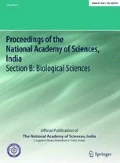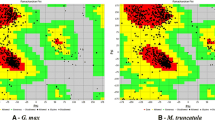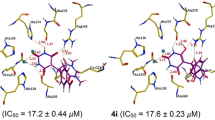Abstract
Urease (EC 3.5.1.5) is an important member of most popular amidohydrolases superfamily that is well known for catalyzes the hydrolysis of urea into ammonia and carbon dioxide. Urease protein exclusively found in a wide range of living organisms including plant, algae, bacteria, fungi and some invertebrates. In plants, urease play an important role of recapturing the nitrogen from urea. Despite its critical interplay in plants the structural and functional aspects of urease in O. sativa are still unresolved. In the present study, a three-dimensional structure of rice urease was deduced by using homology modelling based approach. Molecular dynamics simulations were performed to gain further insight into the molecular mechanism and mode of action of urease of rice. Further, the possible binding interactions of modeled structure of urease with urea were assessed by using a geometry-based molecular docking algorithm. The study reveals the role of Ser324, Ala329 and Val385 of rice urease enzyme in binding with the substrate urea. In conclusion, this study presents a 3D model of rice urease and helps understanding the molecular basis for the mechanism of urease interaction with substrate urea at atomic level.





Similar content being viewed by others
References
Agarwal P, Parida SK, Raghuvanshi S, Kapoor S, Khurana P, Khurana JP, Tyagi AK (2016) Rice improvement through genome-based functional analysis and molecular breeding in India. Rice 9:1. doi:10.1186/s12284-015-0073-2
Vijayalakshmi P, Vishnukiran T, Ramana Kumari B, Srikanth B, Subhakar Rao I, Swamy KN, Surekha K, Sailaja N, Subbarao LV, Raghuveer Rao P, Subrahmanyam D, Neeraja CN, Voleti SR (2015) Biochemical and physiological characterization for nitrogen use efficiency in aromatic rice genotypes. Field Crop Res 175:132–143
Balyan HS, Gahlaut V, Kumar A, Jaiswal V, Dhariwal R, Tyagi S, Agarwal P, Kumari S, Gupta PK (2016) Nitrogen and phosphorus use efficiencies in wheat: physiology, phenotyping, genetics, and breeding. Plant Breed Rev 40:167–214
Holm L, Sander C (1997) An evolutionary treasure: unification of a broad set of amidohydrolases related to urease. Proteins 28:72–82
Karplus PA, Pearson MA, Hausinger RP (1997) 70 years of crystalline urease: what have we learned? Acc Chem Res 30:330–337
Mobley HL, Island MD, Hausinger RP (1995) Molecular biology of microbial ureases. Microbiol Rev 59:451–480
Bremner JM (1995) Recent research on problems in the use of urea as a nitrogen fertilizer. Fertil Res 42:321–329
Sirko A, Brodzik R (2000) Plant ureases: roles and regulation. Acta Biochim Pol 47:1189–1195
Banerjee S, Aggarwal A (2013) Enzymology, immobilization and applications of urease Enzyme. Int Res J Biol Sci 2:51–56
Zonia LE, Stebbins NE, Polacco JC (1995) Essential role of urease in germination of nitrogen-limited Arabidopsis thaliana seeds. Plant Physiol 107:1097–1103
Balasubramanian A, Ponnuraj K (2010) Crystal structure of the first plant urease from jack bean: 83 years of journey from its first crystal to molecular structure. J Mol Biol 400:274–283
Kojima S, Bohner A, von Wirén N (2006) Molecular mechanisms of urea transport in plants. J Membr Biol 212:83–91
Wang WH, Köhler B, Cao FQ, Liu LH (2008) Molecular and physiological aspects of urea transport in higher plants. Plant Sci 175:467–477
Cao FQ, Werner AK, Dahncke K, Romeis T, Liu LH, Witte CP (2010) Identification and characterization of proteins involved in rice urea and arginine catabolism. Plant Physiol 154:98–108
Balasubramanian A, Durairajpandian V, Elumalai S, Mathivanan N, Munirajan AK, Ponnuraj K (2013) Structural and functional studies on urease from pigeon pea (Cajanus cajan). Int J Biol Macromol 58:301–309
Yata VK, Thapa A, Mattaparthi VS (2015) Structural insight into the binding interactions of modeled structure of Arabidopsis thaliana urease with urea: an in silico study. J Biomol Struct Dyn 33:845–851
Filiz E, Vatansever R, Ozyigit II (2016) Molecular docking of Glycine max and Medicago truncatula ureases with urea; bioinformatics approaches. Mol Biol Rep 43:129–140
Gasteiger E, Hoogland C, Gattiker A, Duvaud S, Wilkins MR, Appel RD, Bairoch A (2005) Protein identification and analysis tools on the ExPASy server. In: Walker JM (ed) The proteomics protocols handbook. Humana Press, Clifton, pp 571–607
Geourjon C, Deleage G (1995) SOPMA: significant improvements in protein secondary structure prediction by consensus prediction from multiple alignments. Comput Appl Biosci 11:681–684
McGuffin LJ, Bryson K, Jones DT (2000) The PSIPRED protein structure prediction server. Bioinformatics 16:404–405
Warde-Farley D et al (2010) The GeneMANIA prediction server: biological network integration for gene prioritization and predicting gene function. Nucleic Acids Res 38:W214–W220
Altschul SF, Madden TL, Schäffer AA, Zhang J, Zhang Z, Miller W, Lipman DJ (1997) Gapped BLAST and PSI-BLAST: a new generation of protein database search programs. Nucleic Acids Res 25:3389–3402
Remmert M, Biegert A, Hauser A, Söding J (2011) HHblits: lightning-fast iterative protein sequence searching by HMM-HMM alignment. Nat Methods 9:173–175
Biasini M, Bienert S, Waterhouse A, Arnold K, Studer G, Schmidt T, Kiefer F, Cassarino TG, Bertoni M, Bordoli L, Schwede T (2014) SWISS-MODEL: modelling protein tertiary and quaternary structure using evolutionary information. Nucleic Acids Res 42:W252–W258
Pettersen EF, Goddard TD, Huang CC, Couch GS, Greenblatt DM, Meng EC, Ferrin TE (2004) UCSF Chimera visualization system for exploratory research and analysis. J Comput Chem 25:1605–1612
Laskowski RA, Watson JD, Thornton JM (2005) ProFunc: a server for predicting protein function from 3D structure. Nucleic Acids Res 33:W89–W93
Wiederstein M, Sippl MJ (2007) ProSA-web: interactive web service for the recognition of errors in three-dimensional structures of proteins. Nucleic Acids Res 35W:407–410
Irwin JJ, Sterling T, Mysinger MM, Bolstad ES, Coleman RG (2012) ZINC: a free tool to discover chemistry for biology. J Chem Inf Model 52:1757–1768
Duhovny SD, Inbar Y, Nussinov R, Wolfson HJ (2005) PatchDock and SymmDock: server for rigid and symmetric docking. Nucleic Acids Res 33:363–367
Gajula MNVP, Kumar A, Ijaq J (2016) Protocol for molecular dynamics simulations of proteins. Bio-protocol 6:1–11. doi:10.21769/BioProtoc.2051
Gajula MP, Vogel K, Rai A, Dietrich F, Steinhoff H (2003) How far in silico computing meets real experiments: a study on the structure and dynamics of spin labelled vinculin tail protein by molecular dynamics simulations and EPR spectroscopy. BMC Genom 14(Suppl 2):S4
Maestro-Desmond Interoperability Tools, version 4.0. (2014) Schrödinger, New York, NY. https://www.schrodinger.com/citations
Robertson MJ, Tirado-Rives J, Jorgensen WL (2015) Improved peptide and protein torsional energetics with the OPLS-AA force field. J Chem Theory Comput 11:3499–3509
Ryckaert JP, Ciccotti G, Berendsen H (1977) Numerical integration of the Cartesian equations of motion of a system with constraints: molecular dynamics of n-alkanes. J Comput Phys 23:327–341
Kolafa J, Perram JW (1992) Cutoff errors in the Ewald summation formulae for point charge systems. Mol Simul 9:351–368
Acknowledgements
This work was supported by SERB, Department of Science and Technology, India through Ramanujan Fellowship SR/S2/RJN-22/2011. The authors thank Dr. Prashanth Suravajhala for useful comments and Bioclues.org for proofreading the manuscript. They also extend sincere thanks to Dr. E. A. Siddiq, Professor Emeritus, and Dr. C. Cheralu, Director of Institute of Biotechnology, PJTSAU for their extended support. They highly acknowledge ‘C-DAC, India’ for providing the computational facilities.
Author information
Authors and Affiliations
Corresponding author
Ethics declarations
Conflict of interest
The authors declare that the research was conducted in the absence of any commercial or financial relationships that could be construed as a potential conflict of interest.
Additional information
Significance Statement
The structural insights (3D structure) of O. sativa urease has been deduced followed by identification of its interacting residues during N-recapturing and molecular dynamics. The authors predicted the regulatory partners of urease including nitrate transporters, synthetase, etc. first time in model cereal crop rice boosting the biofortification program leading to crop improvement.
Electronic supplementary material
Below is the link to the electronic supplementary material.
Rights and permissions
About this article
Cite this article
Kumar, A., Kumar, S., Kumar, A. et al. Homology Modeling, Molecular Docking and Molecular Dynamics Based Functional Insights into Rice Urease Bound to Urea. Proc. Natl. Acad. Sci., India, Sect. B Biol. Sci. 88, 1539–1548 (2018). https://doi.org/10.1007/s40011-017-0898-0
Received:
Revised:
Accepted:
Published:
Issue Date:
DOI: https://doi.org/10.1007/s40011-017-0898-0




